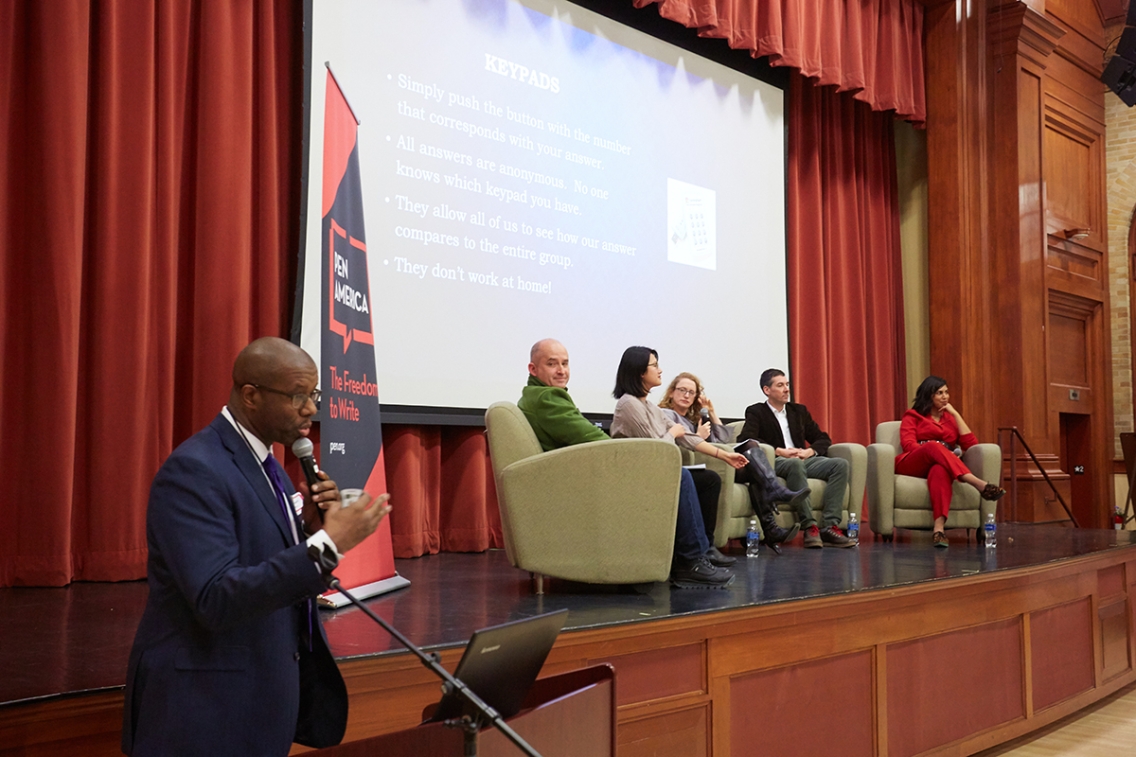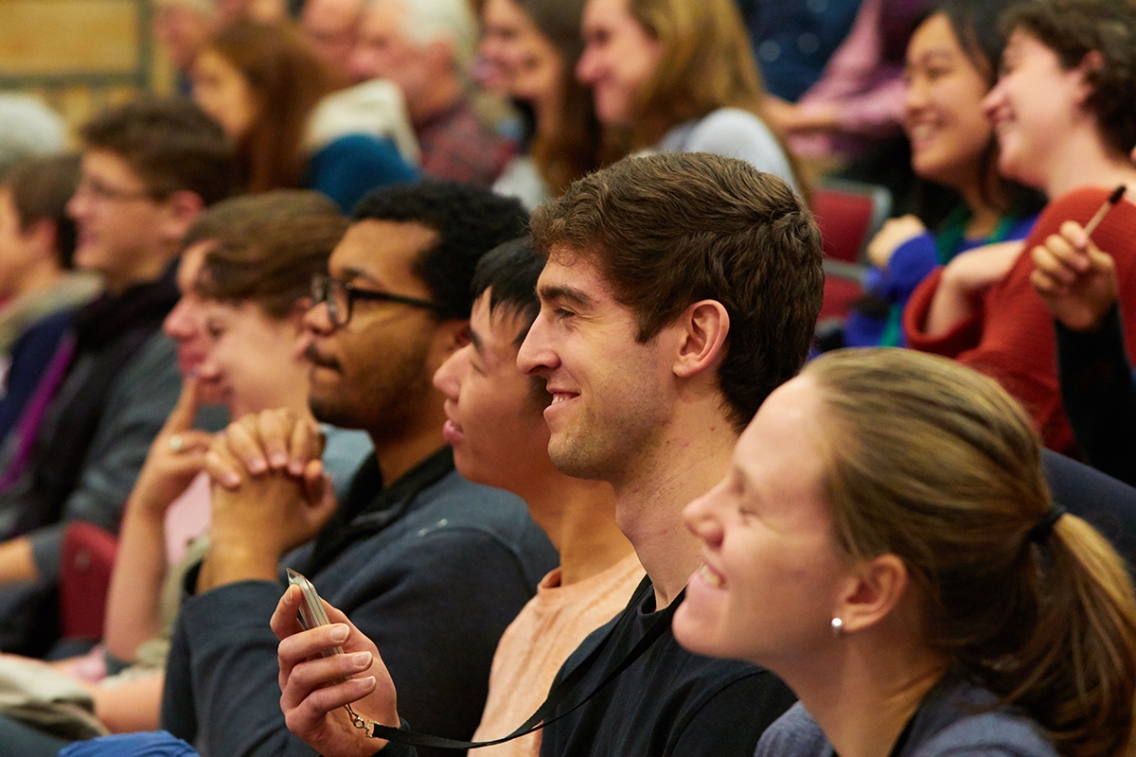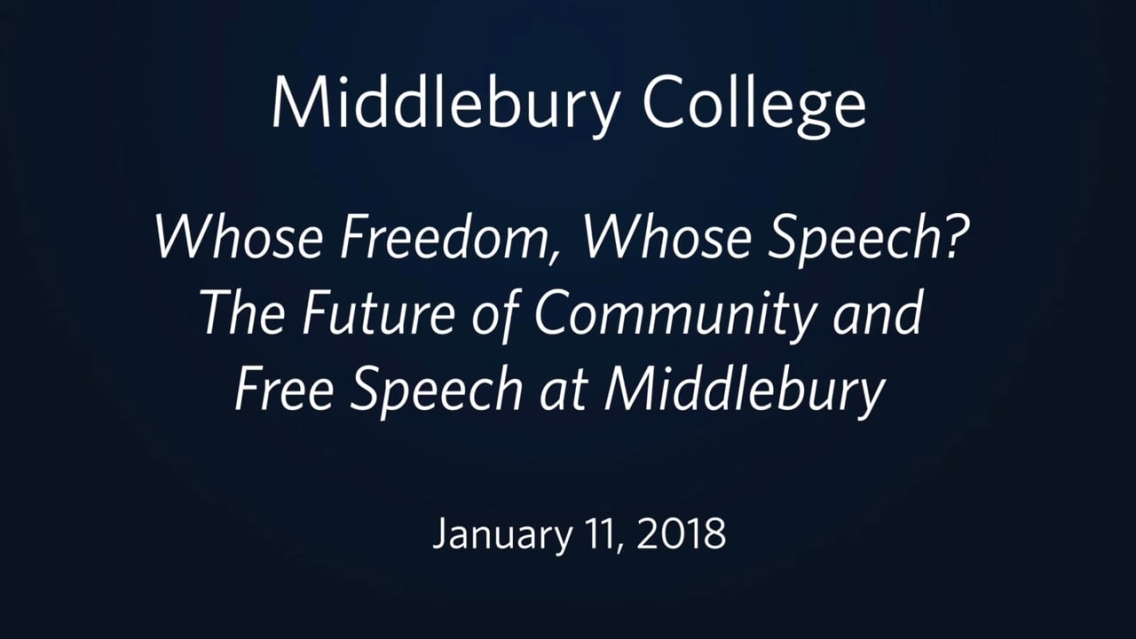PEN America Guides Campus Discussion on Inclusivity and Free Speech
Error message
Could not retrieve the oEmbed resource.
MIDDLEBURY, Vt. – Nearly 200 members of the Middlebury College community turned out on January 11 to witness a panel discussion in Wilson Hall titled “Whose Freedom, Whose Speech? The Future of Community and Free Speech at Middlebury.”
The event was hosted by the College Administration as part of a two-day exploration into the concepts of community, inclusion, and free speech at Middlebury, and it was organized in association with PEN America, a nonprofit organization that “stands at the intersection of literature and human rights to protect open expression in the United States and worldwide.” PEN America’s mission “is to unite writers and their allies to celebrate creative expression and defend the liberties that make it possible.”
PEN America’s Executive Director Suzanne Nossel moderated the 90-minute panel discussion that included: Elizabeth Siyuan Lee ’17, a campaign strategist for coworker.org who was an undergraduate at Middlebury when the Charles Murray incident occurred in March 2017; Roberto Lint Sagarena, associate professor of American Studies and director of intercultural programs; James Lyall ’02, the executive director of the Vermont chapter of the American Civil Liberties Union (ACLU); and Nabiha Syed, the assistant general counsel at Buzzfeed.
Nossel opened the conversation by asking Syed, a graduate of Yale Law School: How, if at all, does the First Amendment come into play at a private college like Middlebury? What parameters does it set in terms of limitations on speech?
“The First Amendment is one of those things where there is cultural meaning layered on top of what the law says,” she explained. “The law is quite narrow. The law says how the government can restrict how the public can speak, protest, assemble, and all of these critical democratic rights. And the law says the government can restrict [free speech] if there is a compelling need in very few categories. You can’t perjure yourself, you can’t commit fraud, you can’t falsely defame somebody, and you can’t endanger public safety.”
“The government is hands off in most cases, except in one of those categories [where there is a ‘compelling need’] and hate speech is not one of those exempt categories.”
On the question of public vs. private institutions, Syed said, “Public universities must adhere to the First Amendment” because they are publically financed, “but for private universities the First Amendment is more of a guiding star. It dictates what they should and should not be able to do. The courts have recognized that universities occupy a special place in society. This is where ideas spring forth; this is where people are trained to think; this is where people engage in this special academic environment. All of the values of how to speak, how to debate, how to assemble, how to petition – all of that has some meaning [at a private institution] even though the First Amendment doesn’t restrict it or dictate it in the way it might at a public institution.”

David Campt, left, of PEN America, guided the audience through a series of demographic questions aimed at helping them better understand who was with them in the room.
James Lyall, the ACLU lawyer, was asked by Nossel if the shout-down tactics employed by Middlebury students on March 2 constituted “an assault on free speech.” To the contrary, he replied that the students’ actions were “an example of free speech in action.”
Pressed by the moderator for more specifics, Lyall said, “Protest is a First Amendment-protected activity and protest is a form of free speech. [The ACLU] would defend the rights of students to protest. We would probably draw the line at the point where the protest literally prevented the speaker from being heard, even though we absolutely recognize and support the sentiment behind the protest in the first place.
“The ACLU is a First Amendment/free speech organization, but we are also a racial justice organization. We are an organization founded on a commitment to justice and equality, and [the ACLU] has never viewed free speech as separate from, or inconsistent with, our commitment to justice and equality. I think there are limits on free-speech principles in a private setting, and my sense is that those limits were breached [on March 2] but, at the same time, I don’t agree with the statement that students today are coddled and that [the Murray incident] was a total attack on free speech.
Professor Lint Sagarena was the next speaker to wrestle with the question of whether the students’ shout-down tactics were an assault on free speech. He said thinking about the Charles Murray incident “in a vacuum does not make sense to me. We really need to think about what was happening in the nation politically at that time, and in some ways the students’ response to Charles Murray was a proxy for the election” of Donald Trump as president.

At the PEN America panel discussion on January 11, the audience was given “clickers” and prompted to answer several demographic questions prior to the start of the panel.
“It became troubling to me to see this [incident] get oversimplified in endless op-eds that seemed to trash Middlebury.” Very few commentators defended the rights of students or considered the tenor of the political discourse at the time, he added.
Elizabeth Siyuan Lee, the recent graduate, agreed that the context in which the event was conducted has been overlooked too often. “To a great extent, people weren’t just reacting to Charles Murray being here. [They were reacting] to the fact that the political science department gave co-sponsorship to the event and that Laurie Patton as president gave the opening remarks, so there were a lot of complex things involved.”
Lee also criticized the format of the Murray event, which was billed as a lecture by the author. “It’s okay to present controversial ideas, but only when both sides are presented on an equal playing field. That way the audience is allowed to draw its own conclusions.”
The lecture format of the scheduled talk proved to be “extremely harmful,” she said. “We should advocate for more classroom discussions and warnings about how [students] can best engage in this type of conversation,” she added.
Nossel, the moderator, gave each panelist another opportunity to share their views before opening up the floor to questions from the audience. And while no clear consensus of opinion emerged, the discussion took the campus one step further toward the goal outlined by President Patton at the outset of the event:
“We share PEN America’s commitment to free speech and we are likewise determined to foster a campus environment that feels open and free to all members of our community,” the president affirmed. “All of us need to work together to build that.”
Reporting by Robert Keren; Photos by Todd Balfour


